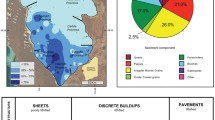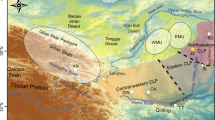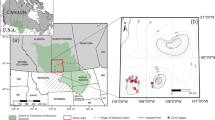Abstract
Chronosequences of freely drained podzols, formed in extensive dune systems of quartz sands along the east coast of Australia, offer unique opportunities for comparing temporal changes in different climatic zones during the late Quarternary. The largest areas and greatest number of dune systems occur along the subtropical coast near Brisbane. Here parts of six dune systems have not been covered by younger deposits and have been exposed to weathering since deposition. These areas constitute a relative age sequence on which podzols have formed with solum depths varying with age from <1 m to >20 m. Absolute ages for each system have not been determined but differences in erosion and weathering depths and comparisons with dated dunes elsewhere along the coast indicate an age sequence extending back at least to the last interglacial. Similarities in geomorphology and soils enable correlation with dune systems in other areas to the north and south and so provide a greater potential for examining temporal changes in soils and biological systems than that of previous soil chronosequences1–5.
This is a preview of subscription content, access via your institution
Access options
Subscribe to this journal
Receive 51 print issues and online access
$199.00 per year
only $3.90 per issue
Buy this article
- Purchase on Springer Link
- Instant access to full article PDF
Prices may be subject to local taxes which are calculated during checkout
Similar content being viewed by others
References
Burgess, A. & Drover, D. P. Aust. J. Bot. 1, 83–94 (1953).
Dickson, B. A. & Crocker, R. L. J. Soil. Sci. 4, 123–154 (1953).
Franzmeier, D. P. & Whiteside, E. P. Mich. Agr. Exp. Stat. Q. Bull. 46, 1–57 (1963).
Cowie, J. D. N. Z. J. Geol. Geophys. 6, 268–280 (1963).
Jenny, H., Arkley, R. J. & Schultz, A. M. Madrono 20, 60–74 (1969).
Bird, E. C. F. in Barrier Islands (ed. Schwartz, M. L.) 410–426 (1973).
Walker, H. J. Soil. Sci. 119, 3–19 (1975).
Shakleton, M. J. & Opdyke, N. D. Quat. Res. 3, 39 (1973).
Thom, B. G. Proc. R. Soc. N.S.W. 98, 23–36 (1965).
Thompson, C. H. Proc. R. Soc. Qd 86, 109–120 (1975).
Thompson, C. H. & Hubble, G. D. Proc. int. Conf. CLAMATROPS, Kuala Lumpur, 179–188 (1979).
Coaldrake, J. E. Proc. R. Soc. Qd 72, 101–116 (1962).
Little, I. P., Armitage, T. M. & Gilkes, R. J. Geoderma 20, 225–237 (1978).
Brewer, R. & Thompson, C. H. Proc. int. Conf. CLAMATROPS, Kuala Lumpur (1979).
Thom, B. G. & Chappell, J. Search 6, 90–93 (1975).
Grimes, K. G. QD Govt Min. J. 80, 79–82 (1979).
Marshall, J. F. & Thom, B. J. Nature 263, 120–121 (1976).
Langford-Smith, T. Search 3, 102–104 (1972).
Ward, W. T., Little, I. P. & Thompson, C. H. Paleogeogr. Paleoclimatol. Paleocol. 26, 305–316 (1979).
Bowler, J. M., Hope, G. S., Jennings, J. N., Singh, G. & Walker, D. Quat. Res. 6, 359–394 (1976).
Jennings, J. N. Geogr. J. 123, 59–70 (1957).
Author information
Authors and Affiliations
Rights and permissions
About this article
Cite this article
Thompson, C. Podzol chronosequences on coastal dunes of eastern Australia. Nature 291, 59–61 (1981). https://doi.org/10.1038/291059a0
Received:
Accepted:
Issue Date:
DOI: https://doi.org/10.1038/291059a0
This article is cited by
-
Impact of soil pedogenesis on the diversity and composition of fungal communities across the California soil chronosequence of Mendocino
Mycorrhiza (2018)
-
Soil Development and Nutrient Availability Along a 2 Million-Year Coastal Dune Chronosequence Under Species-Rich Mediterranean Shrubland in Southwestern Australia
Ecosystems (2015)
-
Subtropical giant podzol chronosequence reveals that soil carbon stabilisation is not governed by litter quality
Biogeochemistry (2015)
-
Structural development of vegetation on rehabilitated North Stradbroke Island: Above/belowground feedback may facilitate alternative ecological outcomes
Ecological Processes (2013)
-
SomeCortinarius spp. (Agaricales) of the Cooloola Sand-Mass, Queensland, Australia
Plant Systematics and Evolution (1990)
Comments
By submitting a comment you agree to abide by our Terms and Community Guidelines. If you find something abusive or that does not comply with our terms or guidelines please flag it as inappropriate.



